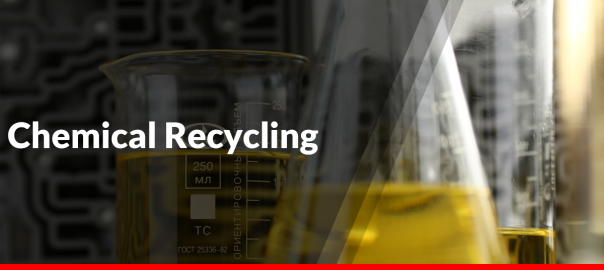What is chemical recycling? When discussing recycling, people usually mean mechanical recycling. When plastics cannot be mechanically recycled according to the required standards from an economic and (environmental) technical point of view (e.g. multi-layer structures of polymers with different melting points), chemical recycling (recycling of raw materials) can offer solutions. Specific examples of such situations are given in the next section.
In chemical recycling, the chemical structure of plastic waste is changed and broken down into the original building blocks (polymers, monomers or atoms) that make up the plastics. This makes it possible to make new plastics, but also products such as chemicals or fuels. 4 different techniques can be distinguished:
- Solvolysis (dissolving)
- Depolymerization
- Pyrolysis (cracking)
- Gassing
These processes break down plastic waste to produce synthesis gas (syngas) and liquid and semi-liquid products. By means of new depolymerization processes, some types of plastics can be converted back to monomers, for the production of new plastics.
This article discusses the advantages and disadvantages of chemical recycling of plastics and discusses the opportunities and challenges of this relatively new development.
Advantages of chemical recycling
Currently approximately 50 percent of plastic packaging waste from households and businesses is recycled mechanically. Current techniques and installations are not capable of recycling all types of plastic packaging. Chemical recycling can help prevent plastic waste from ending up in incinerators or landfills when it is not suitable for mechanical recycling. Examples of advantages of chemical recycling over mechanical recycling are:
- Additives, fragrances and dyes can be separated from the packaging material.
- Combined materials and plastics in one packaging can be separated from each other.
- It offers more possibilities for the application of recyclate in packaging in the food sector.
Waste streams for chemical recycling
Based on the possibilities offered by chemical recycling, which are mentioned above, the following plastic streams are suitable for chemical recycling:
- Sorted mono streams that are too polluted or difficult for mechanical recycling
PVC packaging and laminates, such as potato chips bags, are difficult to recycle using conventional techniques. PET packaging other than bottles and flasks, such as trays and cups are also difficult to recycle mechanically. This, for example, is because different layers are difficult to separate and have different melting points. And with PET trays it is often impossible to distinguish between food and non-food packaging. Which is the case for around 30 ktonnes of plastics a year, as estimated by the KIDV.
- Plastic that breaks down during sorting and recycling steps
The total outage from recycling chains amounts to approximately 52 ktonnes per year. This is 14% of household plastic packaging. Much larger still is the fraction of plastic from municipalities that is mixed with residual waste and ultimately incinerated. This amounts to 195 ktonnes (51%). At the moment, this is not yet be used for chemical recycling, but due to the trend towards more post-separation and pre-sorting at waste-to-energy plants, part of this stream will ultimately also end up with recyclers. As a result, it can also be chemically recycled again.
- Mixed plastic flows
Much of the collected household plastic ends up in the ‘mix of plastics’ stream after sorting. When mechanically recycled, it is then mainly used to make benches, tiles and tables. This is also called low-grade recycling. By chemically recycling these mixed streams, higher quality products could be made and these processes might also score better on CO2 emissions.
- Plastics with additives, fragrances and dyes
Through conventional washing or mechanical recycling, odors and dyes cannot be removed from plastics. As a result, packaging that has been mechanically recycled cannot be used in the food industry. By means of magnetic depolymerization, a form of chemical recycling, dyes and other contaminants are removed. This leads to a high-quality raw material that is equal to the fossil raw material for plastics. This makes it possible to recycle plastic packaging into food packaging.
Disadvantages of chemical recycling
Chemical recycling is not yet widely used. Many companies are still in the development phase. Barriers in regulations do not encourage municipalities to opt for chemical recycling. For example, recycling only occurs when the output is reused as a raw material in the manufacturing industry and not when the output of the chemical processing processes is used as energy or fuel. In addition, collection and sorting fees do not currently apply to plastic packaging that is processed by a chemical recycler. In order to achieve further development, it is important to create an even playing field with mechanical recycling, where these kinds of fees do apply.
Another disadvantage is that the waste flows required for chemical recycling must be cleaner than previously thought. Especially the techniques with a high CO2 reduction also place higher demands on the quality of the waste. Many new chemical recycling initiatives work perfectly on a laboratory scale with clean materials as input. However, practical tests with contaminated and difficult to mechanically recycle waste streams aren’t always successful. And the desirable cleaner input streams already effortlessly manage to find their sales channel elsewhere.
Techniques such as gasification and pyrolysis impose less strict requirements on the input of waste, but these techniques also achieve a lower CO2 reduction.
Furthermore, chemical recycling is often cost-intensive due to the pre-treatment, the amount of energy required and the chemicals / catalysts needed.
As a producer of plastic packaging, we keep a close eye on developments and take part in discussions on chemical recycling.
KIVO is currently only able to mechanically recycle hers and third party waste at our recycling plant REKS. Read more about the closed-loop solutions that our recycling plant offers here.
Do you have any questions regarding this article?
Please contact one of our experienced employees via the contact form below. You will receive a response as soon as possible.

